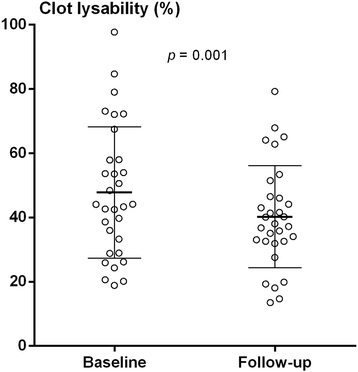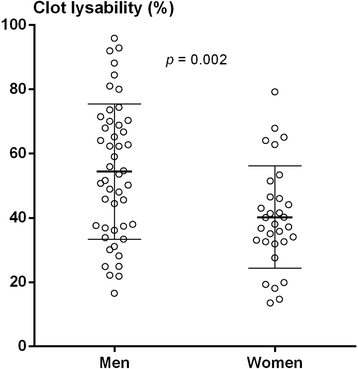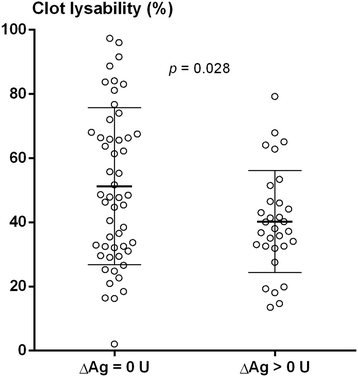Sex difference in clot lysability and association to coronary artery calcification
- PMID: 29439739
- PMCID: PMC5811964
- DOI: 10.1186/s13293-018-0168-8
Sex difference in clot lysability and association to coronary artery calcification
Abstract
Background: Incidence and prevalence of cardiovascular disease (CVD) differ between sexes, and women experience CVD later than men. Changes in fibrin clot lysability are associated with CVD, and the present study addresses sex differences in fibrin clot lysability in asymptomatic middle-aged individuals and the relation to coronary artery calcification (CAC).
Methods: Participants free of morbidities and medication, N = 163, were randomly chosen from a national registry among citizens, 50 or 60 years of age, and were followed for 5 years. CAC was determined by the Agatston (Ag) score both at baseline and at follow-up. Based on the changes in Ag, the population was divided into two groups: ΔAg = 0 U or ΔAg > 0 U. Fibrin clot analyses were based on turbidimetric methods.
Results: At baseline, 116 women and 97 men were included; 84 women and 79 men completed the 5-year follow-up (77%). Independently of covariates, women with ΔAg > 0 had reduced mean (SD) fibrin lysability at follow-up, 40.2% (15.9), both in comparison to baseline, 47.8% (20.4), p = 0.001, to women with ΔAg = 0 U, 51.2% (24.5), p = 0.028, and to men with ΔAg > 0 U, 54.4% (21.0), p = 0.002.
Conclusions: Fibrin clot lysability changes over time with considerable sex differences. Women with progression of CAC have reduced fibrin clot lysability compared to men, indicating a sex-specific association between morphological vessel wall changes and fibrin clot lysability.
Keywords: Cardiovascular disease; Coronary artery calcification; Fibrin clot lysability; Sex difference.
Conflict of interest statement
Ethics approval and consent to participate
All procedures performed in the study were conducted in accordance with the ethical standards of the Regional Scientific Ethics Committee for Southern Denmark and with the ethical guidelines of the 1975 Declaration of Helsinki and its later amendments. The protocol was approved by the Regional Scientific Ethics Committee for Southern Denmark, reference number S20080140 and S20130169 (45023). Written informed consent for study participation and publication of study results were obtained from all individual participants included in the study.
Competing interests
Author Bjarne L. Nørgaard has received research grant from Siemens, Edwards Lifesciences and Heartflow. All other authors declare that they have no competing interests.
Publisher’s Note
Springer Nature remains neutral with regard to jurisdictional claims in published maps and institutional affiliations.
Figures



Similar articles
-
Sex difference in fibrin clot lysability: Association with coronary plaque composition.Thromb Res. 2019 Feb;174:129-136. doi: 10.1016/j.thromres.2018.12.020. Epub 2018 Dec 19. Thromb Res. 2019. PMID: 30597343
-
Differences Between Coronary Artery Calcification and Aortic Artery Calcification in Relation to Cardiovascular Disease Risk Factors in Japanese Men.J Atheroscler Thromb. 2019 May 1;26(5):452-464. doi: 10.5551/jat.44784. Epub 2018 Nov 1. J Atheroscler Thromb. 2019. PMID: 30381612 Free PMC article.
-
Gender Differences in Fibrin Polymerization and Lysability of Fibrin in Patients with Atrial Fibrillation.J Stroke Cerebrovasc Dis. 2016 Feb;25(2):292-7. doi: 10.1016/j.jstrokecerebrovasdis.2015.09.031. Epub 2015 Oct 28. J Stroke Cerebrovasc Dis. 2016. PMID: 26521168
-
Gender differences in the association of epicardial adipose tissue and coronary artery calcification: EPICHEART study: EAT and coronary calcification by gender.Int J Cardiol. 2017 Dec 15;249:419-425. doi: 10.1016/j.ijcard.2017.09.178. Epub 2017 Sep 28. Int J Cardiol. 2017. PMID: 28986055
-
Relation of heart rate recovery after exercise testing to coronary artery calcification.Ann Med. 2017 Aug;49(5):404-410. doi: 10.1080/07853890.2017.1292044. Epub 2017 Feb 26. Ann Med. 2017. PMID: 28166422
Cited by
-
Effects of Interleukin-17A on the Early Stages of Arterial Thrombosis in Mice.Yonsei Med J. 2022 Jul;63(7):632-639. doi: 10.3349/ymj.2022.63.7.632. Yonsei Med J. 2022. PMID: 35748074 Free PMC article.
-
Sex-dependent effects of canagliflozin and dapagliflozin on hemostasis in normoglycemic and hyperglycemic mice.Sci Rep. 2023 Jan 17;13(1):932. doi: 10.1038/s41598-023-28225-8. Sci Rep. 2023. PMID: 36650229 Free PMC article.
-
Sex dimorphisms in coagulation: Implications in trauma-induced coagulopathy and trauma resuscitation.Am J Hematol. 2024 Apr;99 Suppl 1(Suppl 1):S28-S35. doi: 10.1002/ajh.27296. Epub 2024 Apr 3. Am J Hematol. 2024. PMID: 38567625 Free PMC article. Review.
-
Carotid plaque composition by CT angiography in asymptomatic subjects: a head-to-head comparison to ultrasound.Eur Radiol. 2019 Nov;29(11):5920-5931. doi: 10.1007/s00330-019-06086-y. Epub 2019 Mar 26. Eur Radiol. 2019. PMID: 30915562
References
Publication types
MeSH terms
Substances
LinkOut - more resources
Full Text Sources
Other Literature Sources
Medical

